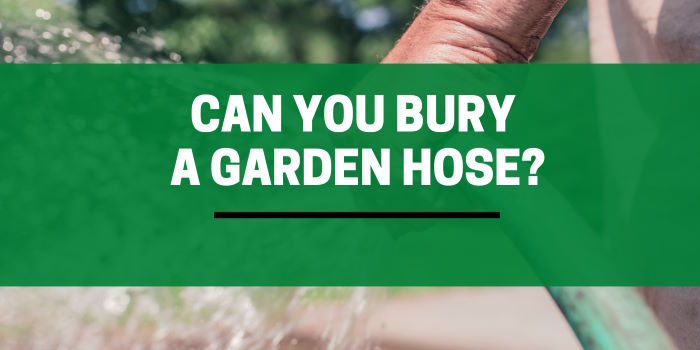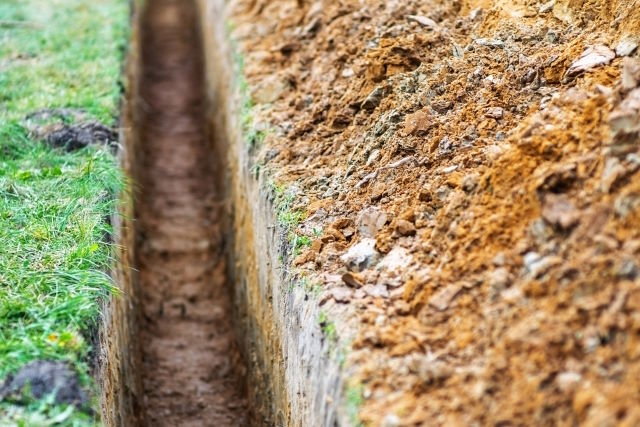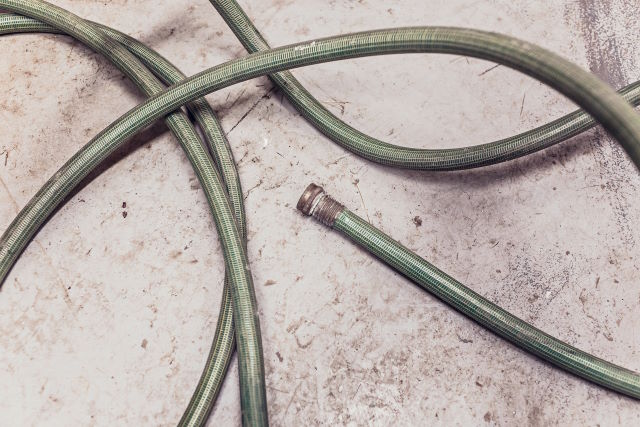
Have you ever wondered if it’s possible to bury a garden hose in your yard? Maybe you’re tired of tripping over it, or you want a more discreet way to water your plants.
In this article, we’ll explore the feasibility of burying a garden hose, the types of hoses you can bury, how to do it, and tips to make the process easier.
Contents
Can I Bury a Garden Hose?
Yes, you can bury a garden hose. But before you start digging, consider a few of the following factors that may impact your decision to move your garden hose underground.

Climate
Extreme temperatures and temperature fluctuations can affect the longevity and functionality of your underground hose. Cold climates may cause hoses to become brittle and crack, while hot climates can cause them to degrade more quickly.
Ground
The type of soil in your garden plays a crucial role in determining whether burying a hose is a good idea. Soft, sandy soil is easier to work with, while rocky or caliche soils can make digging a trench more difficult.
Critters
Animals of all sizes tend to be drawn toward sources of water. Rodents in particular have a highly developed sense of smell and can be attracted to watering systems found in yards and gardens. Whether the hose leading directly from the spigot is exposed or hidden, they will find a way to get to it.
On top of this, certain types of rodents may also decide to dig and burrow around the perimeter of your garden or even directly beneath your hose in order to gain access for drinking or nesting purposes.
What Type of Garden Hose to Bury
When choosing a hose to bury, consider the following options:
Rubber/Polyurethane
Your go-to option for transporting water from point A to point B is undoubtedly a classic rubber or polyurethane hose. These hoses are not only robust but also adapt well to changing weather conditions.
You can trust them not to get squashed under the soil’s weight or develop annoying kinks while you’re laying and burying them.

To maximize water flow, make sure you opt for a hose with a larger diameter – at least ¾ inch is ideal. If you are not sure of the size, measure your hose diameter. Trust me, it’ll make all the difference when you’re using it!
Soaker/Drip
Soaker and drip hoses are designed for underground use, providing slow, deep watering directly to the roots of your plants. These hoses help conserve water and are ideal for garden beds or areas with problematic soil.
How to Bury a Garden Hose
- Plan your route, marking where the hose will be buried, and ensure it connects to a water source, such as a hose bib or combination tee.
- Use specialized tools like a trenching shovel or a power trencher to dig a uniform-depth trench, typically 6-12 inches deep.
- Lay the hose in the trench, ensuring it is flat, straight, and without kinks.
- Test the water flow and see if it has optimal pressure before covering the hose.
- Backfill the trench with soil, tamping it down to prevent air pockets.
- Cover the area with a layer of mulch, turf, or concrete tiles to protect the hose and help blend it into the landscape.
Tips for Burying a Garden Hose
- Avoid underground connections: Minimize the risk of leaks by using a continuous length of hose without underground connections.
- Get the right length: Measure the distance between your water source and the area you want to water to determine the appropriate length. Then shorten the hose if needed.
- Quality: Invest in a high-quality, durable hose to prevent issues like leaks, kinks, and wear.
- Connections and functionality: Ensure your hose connections are secure and functional, including any attachments like sprinklers or drip emitters.
- Should you lay piping?: In some cases, using PVC pipe may be a more durable and efficient option than burying a garden hose, especially for long-term irrigation solutions.
What Tool to Use for Digging a Trench
Choosing the right tool for digging a trench depends on the size of the project and the type of soil you’re working with. Common options include:
- Trenching shovel: A narrow, long-handled shovel designed for digging trenches. It works well for small projects and soft soil.
- Power trencher: A gas or electric-powered tool that quickly digs trenches. This is ideal for larger projects or challenging soil conditions.
Reasons for Burying a Garden Hose
Burying a garden hose has several benefits, including:
- Improved aesthetics: A buried hose is hidden from view, creating a cleaner, more organized appearance in your yard.
- Reduced tripping hazards: With a hose buried underground, there’s no risk of tripping over it while walking through your garden.
- Protection from wear and tear: Burying a hose can protect it from damage caused by sun exposure, foot traffic, and garden equipment.
- Efficient watering: Soaker and drip hoses provide targeted, deep watering to your plants’ roots, promoting healthy growth and conserving water.
Common Problems of Burying a Garden Hose Underground
While burying a garden hose can have its benefits, there are potential issues to consider:
- Leaks: An underground hose is more difficult to monitor for leaks, which can lead to wasted water and damage to your landscape.
- Limited access: In case of a problem or necessary repair, accessing an underground hose is more challenging than one above ground.
- Soil compaction: Digging a trench for your hose may cause soil compaction, which can be detrimental to plant health and growth.
Conclusion
Burying a garden hose can be a practical and efficient solution for watering your garden while keeping your yard tidy and safe.
However, consider factors like climate, soil type, and potential issues before deciding to bury your hose. Choosing the right type of hose, using the proper tools, and following tips for successful installation can help ensure your underground hose system works well for years to come.
FAQs
Is it safe to bury a regular garden hose?
Yes, it is generally safe to bury a regular garden hose. However, rubber hoses or soaker/drip hoses are better suited for underground use.
How deep should I bury my garden hose?
A garden hose should be buried at a uniform depth of 6-12 inches to protect it from damage and maintain proper water flow.
Can I use PVC pipe instead of a garden hose for underground irrigation?
Yes, PVC pipe can be a durable and efficient alternative to a garden hose for underground irrigation, especially for long-term solutions.
Will burying a garden hose affect water pressure?
Burying a garden hose may affect water pressure if the hose is too long or if there are kinks or leaks. Check the water flow and pressure before covering the hose to ensure optimal performance.
Do I need a permit to bury a garden hose in my yard?
Typically, you do not need a permit to bury a garden hose. However, it’s a good idea to check local regulations or consult with your local utility companies before digging. This will avoid any potential issues or damage to underground utilities.
